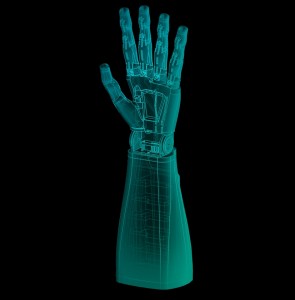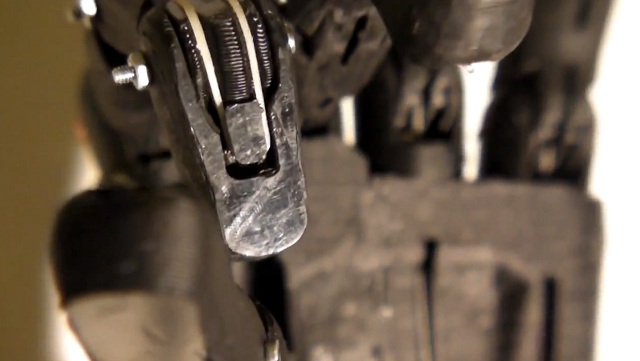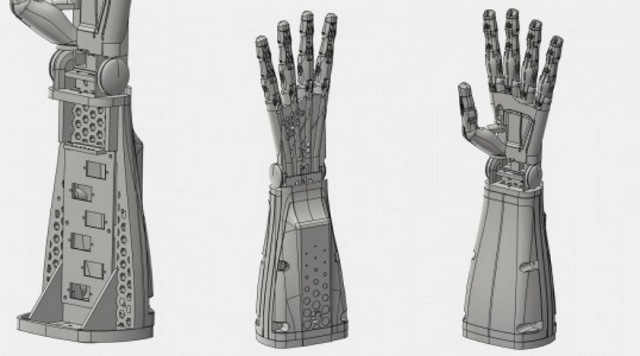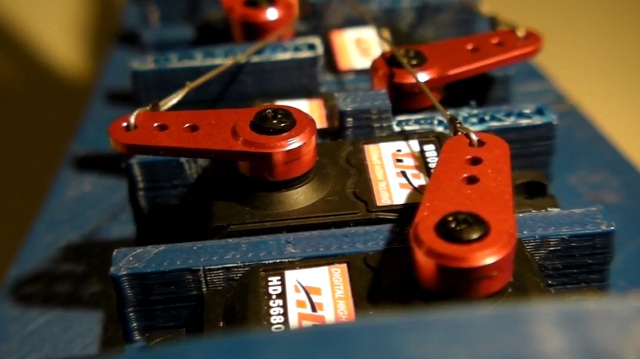A couple of weeks ago we brought 3DPI readers the inspiring story of a self-taught teenager’s 3D printed robotic hand. As with most great future-oriented solutions, however, there are almost always more people involved behind the scenes. And that is exactly the case here. Chris Chappell is a designer-slash-modeller, who has contributed the core design and modeling work for the most recent iterations of the robot hand for the Kickstarter campaign. 3DPI’s Juho Vesanto had the honor of interviewing Chris recently and the results provide some fascinating insight into the project and the motivations behind it. We also hope it inspires you to support the campaign as it launches in any capacity.
To avoid any confusion, note that Chris Chappell is working with Easton LaChappelle (no typo’s and they are not related) on the project.
Juho Vesanto (JV): Chris, please introduce yourself to our readers.
Chris Chappell (CC): Hi, I’m Chris Chappell and for the last 2 years I’ve been focused on lowering the cost of humanoid robotics.
JV: Tell us a bit about your technical background and interests – especially regarding 3D modeling and 3D printing? How were you first introduced to 3D printing?
CC: I was always interested in the ‘broad strokes’ of science and technology. I enjoyed learning and thinking about many different areas and what we’d be able to do in the future.
Probably because of this unwillingness to focus on any one area I chose to study nanotechnology at undergrad and masters levels, at the University of Leeds. This let me learn about many different cutting edge areas, and play with lots of high tech tools, without focusing exclusively on one area.
After graduating though I found my options severely constrained. Maybe that was just how work is, or maybe it was due to the recession, but I found job options very narrow. I might have found many things interesting for a while, but it’s the difference between reading an article, paper or wiki page on a subject, and being forced to read an entire library on one area for years.
I eventually found a PhD position, studying Terahertz Quantum Cascade lasers, at the University of Manchester. It ended up exactly being what I had feared. Interesting on the face, but the novelty wore off and I needed another direction.
I don’t recall exactly where I first learned of 3D printing. My background is steeped in Star trek replicators and Drexlerian manufacturers, so they didn’t appear as a shock. However, RepRap lowering the costs was a shock though. I had spent one summer trying to make my own robot arm, without a 3D printer (or a machine shop for that matter), and found making things such a pain. The idea of just putting a hole in a CAD file and having it ‘just happen’ was what I had wanted all along.
JV: The 3D printed robotic arm project is inspiring and has created quite a buzz around the project in general, but also what’s possible with 3D printing in general. T us about the project – its background and purpose?
CC: For me its purpose fundamentally is to make the best bits of science fiction happen now! I was looking at my skill set, what I wanted a future to look like, and most importantly my wallet and how to combine all three in a satisfying way.
Robot arms really stood out to me for those reasons. My experience of academia, combined with knowledge of the maker movement showed me that many potential researchers were out there, but hamstrung by limited resources. I didn’t have the money to help them out conventionally but I could focus on developing something that would massively lower the bar. A human scale, humanoid arm could be a boon in multiple ways. Prosthetics easily jump to mind as the most obvious and noble goal, but there’s also tele-presence systems such as bomb disposal, hazardous waste etc. There’s also just the cool factor. You show this to children (and plenty of adults) and it inspires them.
If I could do this then it was one rock and a whole flock of birds.
– Below you can see what one of the most recent iterations looks like:
JV: You’re working with Easton LaChappelle on this project – how did your relationship with him begin? Please also elaborate on how the responsibilities/roles are divided between the two of you on this project?
CC: Well I originally contacted him over a year ago, congratulating him on the arm, after reading an article. He thanked me and complimented my designs. Then we didn’t talk again until late 2012. Easton contacted me saying he had an opportunity and he could use my design skills. I was happy to oblige. Over the course of that collaboration we found that our strengths complimented the others. I always had an artistic bent and my strength was in the design side. Easton’s strengths lie in the electronic and programming side.
So what else could we do but come up with an idea for Kickstarter!?
At the moment my role is design work, whilst Easton prints the parts, assembles them and gets it moving. I then improve the design, and he builds, assembles and tests — and repeat. I’ve also tested the design via Shapeways. Once the Kickstarter is funded we will work out the best manufacturing routine to meet the demand, which may involve buying more or faster printers or outsourcing the printing.
JV: Could you tell us what is the current staus of the project and when will we see the next iteration?
CC: Currently we’re focused on polishing the Kickstarter campaign before it goes live. Arm wise we’re at the stage that we have a working prototype. It is being put through its paces, to work out any bugs, or weaknesses of the design, as well as to optimize ease of manufacture. We have plans for a complete arm and shoulder, that we should have moving soon. I’d like to incorporate sensors into the design next. These would be modular and simple to make, which I believe would help attract more interest.
I also have an interest in using a more advanced 3D printer, one that can use multiple materials and digital materials. A combination of rubbery parts, with hard bones and tendons, might make it possible to print a hand in one piece.
JV: You have used at least a Printrbot and in the current stage Shapeways for printing out the parts – what other hardware and software do you use for modelling and printing?
CC: I’ve used Autodesk 123D and Fusion for the design. It’s possible to get some nice organic shapes from them with practice, whilst maintaining engineering precision.
In the past I had experimented with a Bits from Bytes printer, as well as a Chinese CNC machine (when I tested resin casting – also I can’t recommend Michal Zalewski’s guide enough).
JV: The quality and precision are naturally critical aspects in a medical grade & purpose product – are the current means sufficient for producing parts that meet your demanded criteria? Have there been any problems related to the printing quality issue; and if so, what kind?
CC: Precision is certainly a major issue at the moment. I’ve experimented with trying to print moving joints, which has had mixed results.
The advantage of our current arm is that it’s not intended as a prosthesis. It’s a stepping stone until we can reach the level a prosthesis demands.
For an actual prosthesis we will probably need to look at titanium printing. There’s also the issue of it being transcutaneous (through skin) or osseointegrated (anchored to the bone). These are issues that we can’t properly begin to investigate right now.
JV: What are your goals with the [upcoming] robotic arm Kickstarter project? When might we see the project going to full production stage; and do you believe you will be able to keep the price point at $250 as initially planned? (Editor’s note: Easton LaChappelle estimated the cost of the arm v.3.0 to be $250)

However an entire arm, with motors and electronics will come in at several hundred dollars higher. Adding in a control glove will push that higher still. Hopefully with more demand we can save money/buy better parts by placing larger orders.
Full production will begin once we are completely happy with the prototype. If the demand is high enough there might be time spent to source the parts cheaper.
I think the take away is that the difference between the prototype and production model is one of refinement. We aren’t going to change materials or manufacturing methods on our supporters. I’ve already spent the last two years working on that! It’s a matter of scaling up our current abilities.
We should start shipping any rewards, within a couple of months of the campaign finishing.
JV: Besides the primary application of being an affordable aid to people in need, there’s been interest in the project from large companies as well. Heineken has placed an initial order for 5,000 robotic arms to serve beer, but are there any other companies operating in the consumer market that have shown interest – medical or other?
CC: We have had some interest from others, but we decided to focus on the Kickstarter campaign for the next few months. Once we scale up our abilities we will start looking more into the other opportunities.
Taking on too many other clients right now, means working on more designs, with specific requirements and could result in us losing focus.
JV: Do you have plans for other body parts operating with the same basic model – are we going to see robotic legs from you guys as well at some point? Or are there any other 3D printing related projects you personally are working on that you could shed some light on?
CC: Other body parts are interesting, but legs have fewer potential uses outside prosthetics. We would also need to do more modelling of stresses and strains. It’s simply harder to get into with our current resources. It is certainly something on our horizon.
For other 3D printing projects, I’ve been brushing up on tissue engineering (I studied modules on it at University). I’m interested in seeing what I can do from a DIY Bio perspective.
JV: Would you like to add anything else for our readers?
CC: I’m interested in hearing what functions you might be interested in for a robot arm, or what you would like to do with one?
Round Up By Juho
Fascinating stuff, I have to say. For me this proves once again that when somebody is fuelled by true passion, combined with ambition, skills and the right people around them, it leads to something much greater than just the sum of the ingredients.
Of course encouragement from outside of the professional world also gives added value to know that you’re on the right track – which can be seen in the video below of possibly the youngest fan of Chris’ design so far.
You can follow the progress Chris is making even before the Kickstarter project on his website Anthromod.
So now the question remains – what functions would you like to have on a robotic arm or to do with one in general – you can do this in the comment section below.
Cheers, Chris!





